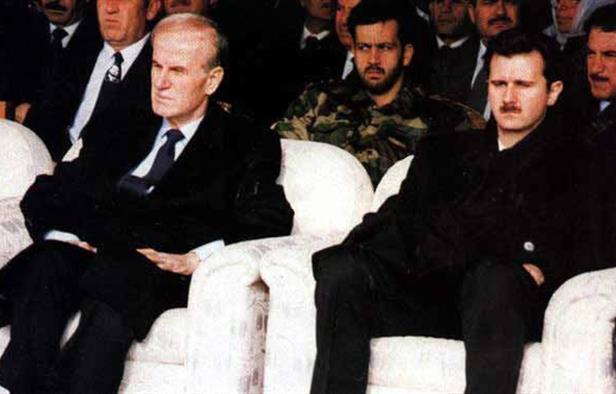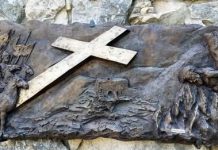34 Years on Hama massacre: Assad doctrine has not changed
Joyce Karam/Al Arabiya/February 04/16
“What are you talking about, 7000…No,no. We killed 38,000”, those were the words of former Syrian General Rifaat Assad in1982 as recounted by Thomas Friedman in his book “From Beirut to Jerusalem”. Rifaat, who is now in exile, was exulting about the number of Syrians his forces killed in Hama 34 years ago, quashing a rebellion against his brother’s dictatorship and setting the stage to what has followed. The ghosts of Hama today hover all over Syria, cementing the pillars of the Assad doctrine to rule by fear and hold on to power at any cost even if it means surrendering the country to devastation, radicalization and ultimate death. From father to uncle to son, the Assad playbook has not changed, copying the narrative of Hama to Homs, Douma, Ghouta, Idlib, Daraa and Aleppo, and in the process leaving behind more than 250 thousands dead, millions displaced, and a society in shambles.
Assad’s playbook
The 3-week assault on Hama in 1982 has laid the ground for how the Assad regime reacts to any signs of rebellion later. Not coincidentally, the same horror tactics utilized in Hama in 1982 with Assad the father were replicated by the son across Syria following the 2011 uprising. In a chilling report by Amnesty International in 2012, survivors of the Hama massacre give their account of what happened, describing images of the dead splintered in the streets, left to be eaten by dogs and as a red flag for those whose lives were spared. Snipers were on the roofs, neighborhoods were razed and one survivor recalls the the attack on Mas’oud Mosque, where “some 60 men were killed before the security forces cut off their fingers and placed them along the mosque’s walls.” She tells Amnesty “for around two years after the massacre, no one dared remove the fingers. They were so frightened.”
The ghosts of Hama today hover all over Syria, cementing the pillars of the Assad doctrine to rule by fear and hold on to power at any cost even if it means surrendering the country to devastation, radicalization and ultimate death. Chopping fingers, slitting throats and maiming children comes to haunt the Syrians 30 years later, with the bodies of teenagers from Daraa who sparked the uprising in 2011 being tortured by the same Assad security apparatus that produced Hama. When that has proven insufficient to suppress the 2011 rebellion, the regime unleashed a blood quenching campaign, that has since broken Syria, rendering it to the mercy of militias, air bombardment, and on the path to fragmentation. While Assad the father benefitted from a media blackout in 1982, and intricate balance he had fostered regionally and globally with both the USSR and the West to avoid international backlash, the son was not as calculated. Bashar Assad borrowed the brutality from his father but not the geopolitical shrewdness. In his 16 years in office, he lost Lebanon, is abhorred regionally, grew dependent on Iran and Russia, and has turned Syria into a hub for sectarian militias and proxy battles attracting mercenaries from Baghdad to Minnesota.
A recipe for radicalization
Assad’s aerial bombardment, use of chemical weapons, and resorting to blockades and starvation as weapons of war has kept him in power but has completely suffocated Syria. Today, the most notorious extremist groups from the so-called Islamic State to Jabhat Nusra to Iraqi Shia militias and Hezbollah, roam freely and control territory in Syria. The state political and economic infrastructure is depleted, and core principles that defined the Syrian Arab identity are replaced by a sectarian and vengeful narrative. The winners of Hama in 1982 were not just the Assad regime and his security apparatus, but also the radicals who exploited those atrocities, to go underground, organize and put together the early cornerstones of Al-Qaeda. It is the likes of Abu Musaab Al-Soori, an extremist with Al-Qaeda who is implicated in terrorist attacks from Spain to Afghanistan, who joined the early ranks of Al-Qaeda after surviving the Hama massacre. In this context, as long as the linkage between authoritarian regimes and the birth of extremism is ignored, there is no plausible way to defeat ISIS or Al-Qaeda or their affiliates. Assad and the radicals are interdependent on each other, and the horror of the first translates into the rise of the second, while borrowing the same tactics. A carbon copy of Assad’s horrors in Hama in 1982, was seen in Palmyra in 2015 where bodies were also left in the streets by ISIS in an attempt to gain the population’s submission. Syria, three and half decades after Hama, is a corpse of a state and a society shattered by the bombs of the dictator and the swords of the radicals. Resurrecting Syria can neither happen with the same playbook and rules that broke it, nor without justice for those whose ashes were left in the streets of Hama and for the many innocent lives desecrated by its rulers.























